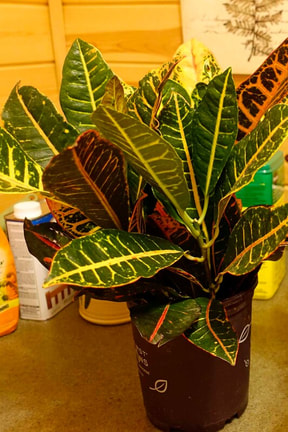Scale & Mealy Bugs They come in various colors and can be armored, soft, or woolly. Piercing-sucking insects that create honeydew and make things sticky. Populations quickly increase and control is difficult. Control of scale and mealybugs: 1) Light infestations can be addressed with a Q tip dipped in rubbing alcohol, 2) Attempt to scrape off insects? 3) Use insecticidal soaps…or something stronger, 4) Remove infected plant tissues, 5) Submerge the entire plant in water? 6) Throw the plant away Note about homemade insecticidal soaps: "New and improved" and concentrated liquid detergents with "grease cutters" and other ingredients have a high potential for being phytotoxic to plants. Proceed with caution. It’s better to go with a product that has been specifically developed and is labeled for your plants. APHIDS: Just like your garden aphids, but may have a waxy coating. They create honeydew, like scale and mealybugs. Scout and catch them early! Control of aphids: 1) Remove plant parts with the worst infestations, 2) Hose down plants or wash them off, 3) Use insecticidal soaps SPIDER MITES: Related to spiders, Suck plant juices and cause yellowing and browning of plant tissues, If populations are high, you will also see webbing. Control of spider mites: Attempt to increase humidity in the home, Periodically wash down houseplants with a strong spray of water; including the lower leaf surfaces, Use miticides labeled for use on indoor plants FUNGUS GNATS: Small flies that infest soil, potting mix, and organic matter, A nuisance pest Larvae primarily feed on fungi and organic matter, but also chew roots, Do not damage mature plants, Can have a generation every 17 days when temperatures are right. Controlling fungus gnats: Target the larval stage, Reduce moisture and organic matter let media dry down between waterings, Use yellow sticky traps to catch adults? Repot using pasteurized potting mix, Will kill flies and the algae and microorganisms they feed on, Place chunks of potato on the plant surface to attract larvae, Consider using nematodes, predatory mites, or Bti (Mosquito Bits, Gnatrol) WHITE FLIES: Tiny, white, moth like insects, Female adults lay eggs on the undersides of the plant’s foliage and the nymphs feed on the foliage, The nymph and adult stages feed by inserting their short, needle like beaks into foliage and sucking out plant sap. Heavy often cause stunting or yellow of leaves, leaf drop, and a decline in plant health. Management: 1) Prevention is the best management strategy, 2) Check newly purchased plants and plants brought indoors from the garden or patio in the fall, 3) Begin control measures at the first signs.4) One way to reduce the whitefly population on an infested plant is to wash the undersides of the leaves with a moist cloth or sponge, 5) Use yellow sticky traps, 6) Insecticides specifically labeled for use on houseplants can be used, 7) Discard heavily infested plants SCALE: Sucking insects both soft shelled and armored, Soft shell will produce honeydew, Heavy infestations may cause leaf yellowing, stunting, and dieback Management: Scrape off, if possible, Wash off or crush any visible scale insects, Treat with an insecticidal soap or horticultural oil labeled for houseplants, Can use systemic houseplant insecticides, Heavily infested plants should be discarded FOLIAR Disease: Bacterial and fungal leaf spots: Decrease stress, Remove infected leaves and plant parts: Powdery mildew: Increase circulation around the plant; lower humidity, Remove infected leaves; Viruses: No cure; destroy plant GENERAL DEFOLIATION: Likely causes: Sudden change in temperature, Transplanting shock, Sudden change in light intensity, Over watering, Lack of light BROWNING LEAF TIPS: Likely Causes: Improper watering (such as water being too cold), Exposure to cold drafts, Insect attacks, Excess fertilizer, Floride or Boron deficiency (allowing water to sit for day before watering can help reduce floride.) ABNORMAL LEAF COLOR: Likely Causes: Over watering, Lack of fertilizer, Insect attacks, Improper light SPOTTED LEAVES: Likely Causes: Over watering, Burning from direct sunlight, Disease REPOTTING: tips on when a plant might need repotting:
PRUNING: All houseplants (with the exception of palms and Norfolk Island pine) can be top pruned to encourage new lateral growth. The best time to prune is in Spring, when growth usually occurs. DUST CONTROL: Keep houseplants clean by carefully washing foliage. Washing leaves with water or cleaning with leaf polish is not recommended on plants with hairy leaves. Rinse plants off with room temperature water in a shower or sink. Use a soft, damp cloth to wipe foliage. Leaf polish products should be used sparingly and only on plants with firm foliage. Master Gardener Vicki Gee Treft writes about what she learned from a "HOUSEPLANTS" course presented by Katie Dunker from the Colorado State University Extension.
1 Comment
3/13/2023 04:35:42 pm
Great tip about checking roots that appear on the surface. My wife and I need to find out which bugs are in the trees. They keep eating the branches.
Reply
Leave a Reply. |
|
| North Country MGV | gARDEN bLOGS |
Location |
|

 RSS Feed
RSS Feed